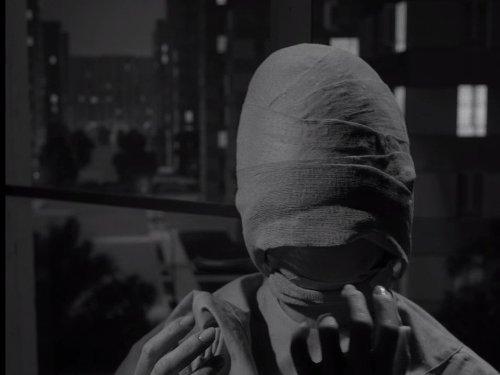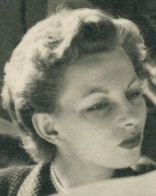
“I want to be like everybody else. Please doctor, please help me.”
Title: “Eye of the Beholder”
Original transmission date: November 11 1960
Written by: Rod Serling
Directed by: Douglas Heyes
Starring: Maxine Stuart
Donna Douglas
William D. Gordon
Jennifer Howard
Edson Stroll
Setting: Earth
Timeframe: Present (at the time)
Theme(s): Isolation, being different, fear, conformity, beauty, totalitarianism
Parodied? Not to my knowledge, no
Rating: A++
Serling's opening monologue
Suspended in time and space for a moment, your introduction to Miss Janet Tyler, who lives in a very private world of darkness. A universe whose dimensions are the size, thickness, length of the swath of bandages that cover her face. In a moment we will go back into this room, and also in a moment we will look under those bandages. Keeping in mind of course that we are not to be surprised by what we see, because this isn't just a hospital, and this patient 307 is not just a woman. This happens to be the Twilight Zone, and Miss Janet Tyler, with you, is about to enter it.
A woman lies in a hospital bed, her face entirely covered by bandages. Apparently she’s been through an operation to correct some terrible disfigurement, but the nurse who attends her will not be drawn on when the bandages can come off, or whether or not the operation has been a success. Talking to a fellow nurse later, the one who attended the patient laments over how horrible her face is, oozes sympathy but also a definite repugnance at the idea, and gratitude that she is not in her place. We now learn that this is the patient, Janet Tyler’s eleventh attempt to have the doctors correct her facial flaws, and nothing has worked. Frankly, the doctors think there is nothing to be done. Janet recalls the horror of being stared at, run from in the street, treated as a monster, and all she wants is to be normal, but this seems beyond the current abilities of medical science.
The doctor advises her - as she already knows - that she has now reached the maximum allowable operations. After this, there can be no further attempts. She fears it won’t work - why would it, when she’s already gone through ten failures? Her options, in the event she remains as she is, untreatable, seem to be few. She may be invited (read, forced) to move into an “area where others of your kind congregate” (read, ghetto). She starts to rail against the state, asking who made the rule that those who are different can’t live among “normal” people? It isn’t right, she screams, and demands the bandages be removed. As she is getting hysterical, the doctor agrees.
Later, the doctor confides to the nurse that he feels sorry for Miss Tyler, that he at least can see beyond the wreckage that is her face, to the soul beneath, and he growls in agreement with her earlier, that it’s not fair. The nurse shushes him fearfully, warning him he is saying things that are tantamount to treason. The state is never wrong, and must not be questioned. He sighs and says he knows she’s right, but he just feels so sorry for the woman. At the nurses’ station, a transmission from the leader is broadcast, in which he speaks about the “glory of conformity”.
Back in the ward, the doctor tries to prepare Miss Tyler for what they both know is likely to be yet another disappointment, and the final one too. She promises she will remain calm. But when the bandages come off and there is no change she freaks out. Dashing off before they can sedate her, she runs through the hospital as people watch her in revulsion and pity - this perfectly beautiful woman, not a blemish on her skin! So unlike all of them, with their twisted, pig-like faces so correctly and normally warped and contorted into almost animalistic looks. Above, on the monitor, the glorious leader goes on about rooting out the cancer in society, all that is different, all that is abnormal, all that does not conform to the state’s ideal of beauty.
She eventually ends up running back into the doctor, who introduces her to a man, a man just like her, another “aberration”, who will bring her to the “village” where “their kind” must live. He tells her it’s a fine place, and everyone there is just like her, and in a very short time she will realise how nice it is there, and how she can live a full and happy life there. As they leave, Miss Tyler asks the man, Walter Smith, why they are as they are, and he has no answer, but tells her it doesn’t matter. In the village, she will not be seen as a freak, but loved and included. The doctor, who has done all he can for her, sheds a tear as they depart, knowing there was no other way.
Serling's closing monologue
Now the questions that come to mind: "Where is this place and when is it?" "What kind of world where ugliness is the norm and beauty the deviation from that norm?" You want an answer? The answer is it doesn't make any difference, because the old saying happens to be true. Beauty is in the eye of the beholder, in this year or a hundred years hence. On this planet or wherever there is human life – perhaps out amongst the stars – beauty is in the eye of the beholder. Lesson to be learned in the Twilight Zone.
The Resolution
Absolutely tremendous. Not only does it encapsulate the title in a nutshell, but it asks some very hard questions, especially for the sixties, such as what is normal and why are we so repelled from those who are not what we see as normal?
The Moral
It’s in the title. It
is the title. It’s one hundred percent perfect.
Themes
Perspectives is the first that comes to mind, though whether you could call that a theme I don’t know. Conformity is certainly one, especially enforced, state conformity - those who do not fit the expected standard are sequestered away in “villages”, a chilling echo perhaps from not so long ago? Isolation hangs heavy over this episode, with Janet spending almost the entire thing swathed in bandages, visited only by her doctor and the odd nurse, not even allowed to go outside. Fear, too: fear of what will happen to her if this, her last chance, fails? Sympathy and pity, though only really from the doctor and technically from one nurse, though whether it’s more a cruel kind of pity, a “poor cow” sort of idea, I’m not sure.
There is definitely a theme of totalitarianism running through this episode; I’m sure it’s no coincidence that the “leader” looks and acts like a Nazi, and the idea that everyone is forced to conform, that (presumably) “undesirables” must be reported and dealt with, and that even daring to question, privately, the wisdom of the law is to invite charges of treason all speak to a society deeply oppressed by the ruling class. At the beginning, hope - that this procedure will finally work - and at the end, when all seems lost , hope returns as Smith tells her she will be cherished and loved at “the village” (and The Prisoner wasn’t even written at this stage!). There’s even the idea of exterminating, as they put it, Janet for her “disfigurement”, a fate she actually begs for.
Can beauty be considered a theme? Given the title it's no real surprise that beauty, or one idea of it, drives this episode, but a beauty which, to us, is totally warped and wrong. This also speaks to how normality is perceived: if everyone is ugly, is anyone ugly? If everyone is cruel, is anyone cruel? Is the right, or accepted thing only that which the majority agrees with and sees as being the true path, or indeed that which they are told is so? Can reality be shaped by those in power, so that those under them blindly believe everything they're told. As someone once asked, is there, in truth, no beauty?
And isn't that...?
 Maxine Stuart (1918 - 2013)
Maxine Stuart (1918 - 2013)
In a long and distinguished career on TV and in films she had roles in
Private Benjamin opposite Goldie Hawn,
The Prisoner of Second Avenue opposite Jack Lemmon, and TV shows such as
The Asphalt Jungle, The Outer Limits, Trapper John MD, NYPD Blue, Chicago Hope and
The Wonder Years, for which she was nominated for a Primetime Emmy Award.
 Donna Douglas (1932 - 2015)
Donna Douglas (1932 - 2015)
Best known for her role as Ellie May in
The Beverly Hillbillies for nine years, and on screen she worked with Rock Hudson, Doris Day, Dean Martin and Shirley McLaine, as well as the King himself, Elvis. When
The Beverly Hillbillies finally ended she changed careers, becoming a gospel and country singer, and an author, and filed lawsuits against Disney for plagiarising her novel for the movie
Sister Act (a case she lost, for who takes on Disney and wins? And yet she was offered a million dollars - which she perhaps foolishly turned down - to settle out of court, so they must not have been quite as confident as you would think) and another against Mattel, for using her likeness with one of their dolls without her permission. Details of that one are confidential, apparently.
William D. Gordon, who played George in “Nervous Man in a Four Dollar Room”, and whom we didn’t mention as his credits are more in the writing sphere than acting, and so nobody would be expected to know him, features here again as the doctor.
 Jennifer Howard (1925 - 1993)
Jennifer Howard (1925 - 1993)
If famous for nothing else, she deserves mention as the second wife of Samuel Goldwyn, mogul boss of MGM Films.
 Edson Stroll (1929 - 2011)
Edson Stroll (1929 - 2011)
Another who worked with Elvis, this time on
GI Blues, and also The Three Stooges on two of their movies.
Those clever little touches
I love the way this is shot. The camerawork is terribly clever, used in such a way that until the big reveal you see no faces. Janet of course is bandaged up, but through a mixture of non-head shots, shadows on walls, shots of backs and top-down views no other faces are seen at all until Janet’s bandages come off, making the shock that much more potent.
Sussed?
Absolutely not. The first time I saw this I was blown away by the reveal.
The WTF Factor
A top level 10 here.
Personal Notes
I take my hat off to Maxine Stewart, who spent the entire episode with her face covered in bandages, and even when they were removed it was another woman - Donna Douglas - who was revealed as the face of Janet Tyler. Quite an actress, who can perform under - presumably - hot studio lights with all that on her face, and still give a powerhouse performance. I think I’d be right in saying this is the first episode to do something that would become a staple of the series, which is to look at ordinary things from a very different perspective, the idea of looking through the microscope from the point of view of the cell rather than the scientist, of not taking anything for granted and turning accepted norms upside down.